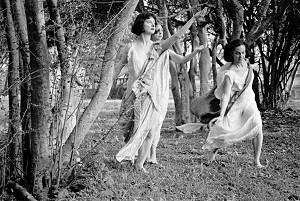Kathryne Cassis is a dancer and that means she must express herself in movement; words are not enough, every thought becomes a miniature ballet, and a conversation with her is a private performance. Her deep love is for the dances of the historic yet timeless Isadora Duncan (1882-1927) who took her inspiration from Greek vases, sculptures and paintings, and Cassis is one of the heirs to her repertoire.
Music and dance were in the air she breathed in her home in Baltimore. Both her parents were musicians. Her father played the cello and coronet and later became a builder of baroque instruments some of which are in the Smithsonian Institute. Her grandmother and grandfather, who was a Greek Orthodox priest, came to the U.S. from Hydra in 1925 and her other grandparents were from Syros and Andros. She grew up in the Greek culture and at all of the many family gatherings every kind of musical instrument would be brought out and played. "My father had six brothers and sisters, all of whom played instruments, so our parties were joyous exhuberant affairs. We all danced. As soon as we could walk we were dancing. My father thought it was important for us to learn all the Greek myths, so that my Greek heritage is very strong. We were also solidly attached to the church. I spoke Greek before I spoke English."

Cassis was fortunate in seeing this work performed by Hortense Kooluris
who had been a member of the Irma Duncan company. Irma Duncan was one
of Isadora's six adopted daughters - affectionately called 'The Isadorables.'
When Isadora died in 1927 three of her daughters formed dance companies
which performed a hundred of her dances. Irma passed the repertoire to
Hortense, who eventually taught Cassis. It's an awe-inspiring heritage.
They range from little studies of a few minutes long, to entire movememnts
of symphonies. Somewhere along the line twenty were lost but there is
a small but strong, ardent cadre of dancers who keep the flame alive.
When she was living in New Orleans, Cassis found a woman who had a Duncan company, a student of Mignon Garland who had also been in the Irma Duncan company. "It was a heady time. I was dancing with this company and commuting to New York to study with Hortense, and soon learned the different aspects of Duncan's work. It became a whole world for me, especially being Greek, it hit a cord. Her dancing was inspired not only by Greek art, sculpture, and philosophy but also early 20th century thoughts about the culture.
"Like the Greeks
Duncan studied nature - at same source as they did - the movement of animals
and birds in flight, wave patterns, waves crashing against the shore.
She said 'dance waves, light waves and sound waves are all the same,'
and in the movements of her dances you can see it, the undulating, the
impulse and release, movements that come from the center of the body.
Her work is characterized by powerful emotion."
Eva Palmer-Sikelianos has described Duncan as 'the personification of Greece' though she felt that Duncan took her inspiration from later Hellenistic bas-reliefs rather than the archaic or classical ages. Duncan herself has claimed the foundation of her art was the American Pioneer spirit together with Irish jigs her grandmother taught her! Whatever the source of her inspiration Duncan is appropriately called the 'mother of modern dance'; she redefined the medium, creating a a unique dance vocabulary from scratch. She was the first choreographer to use serious classical music. Previously ballets used music composed specifically for them or fell back on trivial music, but Duncan used Chopin, Brahms, Gluck, Wagner. It created a lot of controversy in her day. Many people stalked out of her performances while others cheered enthusiastically. She was the first dancer to free herself from corsets and bare her legs, and while she did wear a light undergarment her tunics were quite revealing. "Duncan said dance without spirituality was mere merchandising and the Greeks thought so too. It was part of the ritual which we have sadly lost today" said Cassis.
Cassis was on staff at the New Orleans School of Ballet for seven years while also performing, lecturing and teaching at cultural and educational venues throught the U.S., including the Hellenic Arts Society, Lincoln Center, Common Ground Theatre New York. In 'Orchesis Review' Jerry Weinstein described her performance as "hauntingly powerful, romantic ecstasy" and Gambit Magazine said 'Kathryne Cassis is a sincere, gifted and disarming Isadora Duncan dancer.'
In 1997 she moved to San Francisco with her painter/filmmaker husband, Cy Bowers, and began teaching. There she met up with Mignon Garland again, and with other Duncan dancers began an ambitious project to chronicle on videotape all the Duncan dances they knew. Between them they recorded about 80 of the 100 dances, with the variations that inevitably occur when different artists perform them.
"When I came to Los Angeles two years ago ago" said Cassis, "the first thing I did when we settled in was to attend a St. Sophia service and make the important connection to Greek people.
"The next thing was to find a studio and begin teaching. Women in particular who come to my class love it because it's about the strength of women; even the lightest of dances have that vitality. An added benefit is they are accessible to all ages of adults, and every level of dance knowledge."
For more information on these classes, or availability for deomonstration lectures, phone Ms Cassis at (323) 937-7759.
